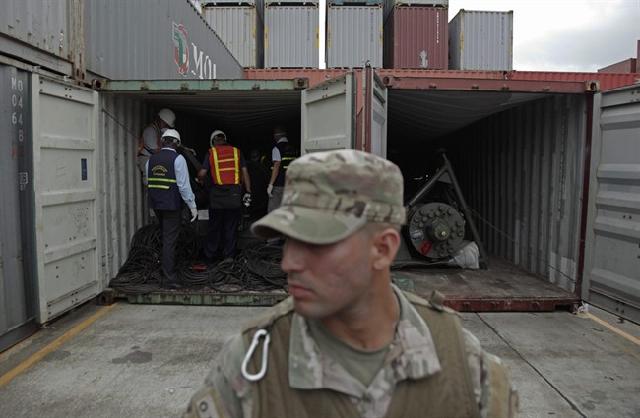This story keeps getting bigger and the implications are huge.
PANAMA CITY — Two Cuban MiG-21 jet fighters found aboard a seized North Korean cargo ship three months ago were in good repair, had been recently flown and were accompanied by “brand-new” jet engines, Panamanian officials say.
The assertions deepen the mystery around the Cuban military materiel that was found aboard the 508-foot North Korean freighter Chong Chon Gang, which Panamanian authorities intercepted July 10 off the Atlantic entrance to the Panama Canal.
“They had jet fuel still inside their tanks,” Foreign Minister Fernando Nunez Fabrega told McClatchy in an interview earlier this month. “They were not obsolete and in need of repair.”
One of the MiG-21s contained manuals and maintenance records that indicated it was flying just a few months earlier, said prosecutor Javier Caraballo, who’s handling an arms trafficking case against the 35 North Korean crew members. Caraballo declined a reporter’s request to see the records.
In publicly acknowledging the shipment after it was discovered, Cuban officials insisted that the ship was carrying only old aircraft and other parts that were being sent to North Korea for repair when Panamanian authorities, acting on a tip that it was carrying drugs, intercepted it.
Panamanian officials now think that the shipment was part of what Nunez Fabrega called “a major deal” between the two countries, though they aren’t certain of its scope.
Officials searching the vessel found the MiG aircraft in sealed containers hidden under 100-pound bags of sugar – 10,000 tons worth – in the ship’s hold. They also uncovered 15 jet engines and other weaponry.
“These are brand-new engines,” Nunez Fabrega said. He said Cuban officials in their public statement also “generalized over very specific items that could have gotten them in trouble,” such as a guidance system for anti-aircraft missile defense.
The United Nations has imposed an embargo on arms shipments to North Korea stemming from that country’s 2006, 2009 and 2013 nuclear tests. A six-member U.N. team led by David Martin Uden, a former British diplomat who’s the coordinator of a U.N. unit that monitors enforcement of those sanctions, examined the seized armaments during a visit to Panama in mid-August.
Reached by telephone, Uden said his office “can’t comment on what we found down in Panama.”
The U.N. monitoring team still seeks answers from Cuba about the arms shipment, and the team will provide a U.N. sanctions committee with a detailed report once it has those answers.
A senior aide to the foreign minister, Tomas A. Cabal, said the deal had been arranged at a meeting June 29 in Havana among Cuban leader Raul Castro, Cuban Revolutionary Armed Forces Gen. Leopoldo Cintra Frias and Kim Kyok Sik, who was then the chief of the Korean People’s Army general staff. Kim was dismissed from his post in August, a month after the ship was seized.
Cabal said “friends overseas” had told Panama that the two MiG-21s were part of a larger deal between Cuba and North Korea for 12 jet fighters. That assertion couldn’t be independently confirmed.
Meanwhile, the 35 crew members from the Chong Chon Gang are biding their time at a former U.S. military base near the Panama Canal. It’s not exactly hard time, officials say. In fact, it’s better than living aboard the vessel, which reeked of poor hygiene when it was seized.
Caraballo said the crew members, while under armed guard, were enjoying conditions that were “10 times better than where they were.”
“They are quite comfortable,” Caraballo said. “They’ve been given clean clothing, food, cigarettes to smoke. . . . They have a television. They can play soccer each afternoon.”
They live in air-conditioned quarters, a physician attends to them and a telephone is available for them to communicate with the North Korean Embassy in Havana, he said. Panama doesn’t have diplomatic relations with North Korea.
While the ship’s crew and captain have offered statements through Korean translators brought in from Mexico, they’ve refused to sign the depositions, Caraballo said.
It hasn’t been decided what will happen to the weaponry that was aboard the ship.
Panama is treading lightly in the case, wary of angering Cuba, which Nunez Fabrega said was “one of the biggest customers of the free zone” in Colon, where it buys abundant goods as a consequence of the five-decade-old U.S. embargo on the island. A ship travels weekly from Colon to Havana to supply Cuba’s tourist hotels.
Caraballo, a drug prosecutor who was summoned to handle the seized ship because initial reports said it was carrying narcotics, said the captain had affirmed that he knew containers were in the hold but “didn’t know what was in the containers.”
The North Koreans have been charged with arms trafficking, which could carry up to a 12-year term, Caraballo said.
But Nunez Fabrega said Panama was eager for the crew and ship to be on their way once North Korea settles a fine of up to $1 million imposed by the Panama Canal Authority for endangering the waterway by transporting undeclared weaponry.
“We have no interest in keeping that boat here,” Nunez Fabrega said, noting that it’s the largest freighter in North Korea’s merchant fleet.
As for the seized sugar, it’s being kept in silos in Penonome in central Panama’s Cocle province, Caraballo said. What will happen to it is unclear. “This sugar may last there another 10 months without it being damaged,” he said.

